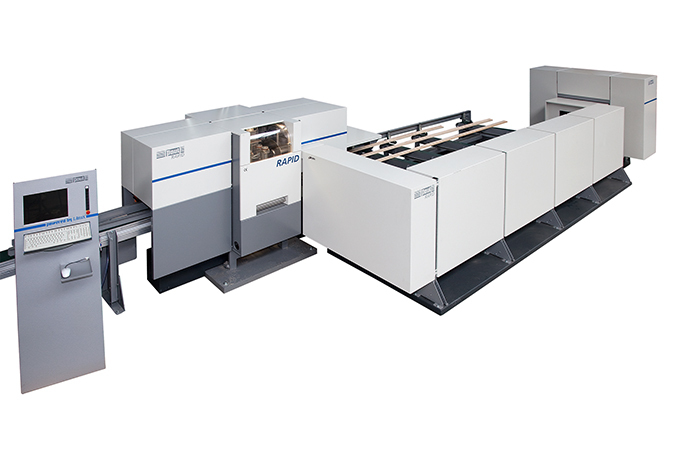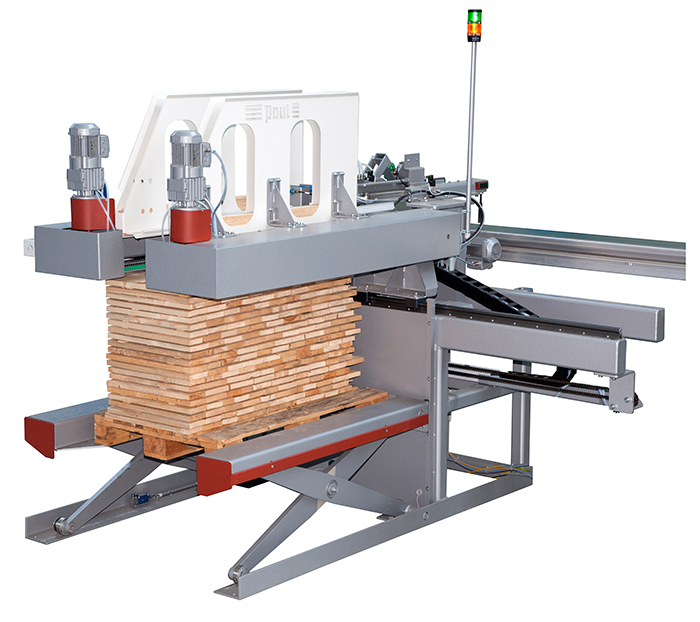 [Translate to English:] Von dieser Kappsäge vom Typ RAPID sind in der Anlage vier Stück verbaut.
[Translate to English:] Von dieser Kappsäge vom Typ RAPID sind in der Anlage vier Stück verbaut.
Fruit Growers Supply Company based in California is part of the Sunkist Group. For over 100 years “FGS” has produced cases and packaging materials for various applications. They also have factories in Washington, Oregon and Arizona. Apart from wood products they make carton packages. The raw materials used come from sustainable and certified forestry.
In the modern wood processing industry fully automatic high-efficiency systems are also becoming an ever more important aspect in cutting raw wood. An essential element thereby is an upstream scanner recognizing the relevant wood characteristics on all four faces of the workpiece at tremendous speed and determining the optimum cut length combination with minimum waste. The high output capacities achieved on automatic processing lines would be unthinkable without this kind of automatic defect identification system and a control technology meeting the highest demands.
For an increase in production capacity and yield optimization, FGS decided to purchase two PAUL RAPID_SCAN_DUO Cross-Cut Systems with 6 auto stackers. This was an interesting challenge for the development department at PAUL. Apart from varying workpiece lengths and widths the system was required to process mixed workpiece thicknesses at maximum speed.
The logs, pre-sorted at the log yard, pass through a measuring system to determine their optimum ripping position. After turning them to the right position, the green logs are fed into a chipper line producing the workpieces to be cross-cut. A generously dimensioned cross-transfer buffer distributes the workpieces to two feeding systems singulating them ahead of the automatic defect identification system. To meet the customer’s requirements, the scanner runs at a feed speed of approx. 300 m/min., i.e. 5 m/sec. One model RAPID cross-cut saw is capable of processing a 4.88 m workpiece with 5 cuts in 3.2 seconds. This gives an input of 91.8 m/min, i.e. 36,700 lineal meters per saw and shift. Accordingly, the theoretical maximum capacity of their overall cross-cut system comprising two scanners and four RAPID cross-cut lines is approx. 146.8 kilometers per shift.
The PAUL Wood Scanning System detects all geometric deviations and wood characteristics on all four faces of the workpieces. This ensures maximum yield optimization with highest productivity. Thanks to the user-friendly software, system adjustments or the definition of the defects to be cut out are very easy to realize. Statistical data provide information on the production sequence and a complete overview of the workpieces processed. All defects are classified based on their length, width, diameter, area and location in the longitudinal and transverse direction. Different optimization criteria can be defined according to the type and position of the defects. The system allows the definition of “products” depending on width, length, grade, price, quantity and other criteria. The relevant data, such as cutting positions, quality, length, marks, box allocation, etc. are transferred to the cross-cut saw for each piece.
The six (3 top and 3 bottom) powered feed rollers on the PAUL RAPID cross-cut system ensure efficient workpiece guidance and highly accurate length cutting even with rough sawn and difficult workpieces. Two overhead saw blades, one of them exclusively for trailing end cuts, ensure a smooth, trouble-free waste disposal eliminating downtimes. The robust construction and use of standard components make the PAUL RAPID a cost-effective investment.
Following the cross-cutting operation the individual pieces are sprayed to prevent mold formation. A total of six auto stackers form the stacks including sticks as required by the customer. The finished stacks are moved to a central transfer point for onward transport. About every 40 seconds a completed stack is ready for removal.

